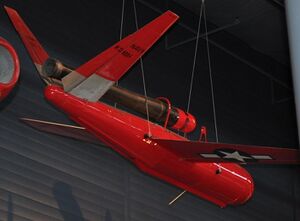Engineering:McDonnell TD2D Katydid
The McDonnell TD2D Katydid was a pulsejet-powered American target drone produced by McDonnell Aircraft that entered service with the United States Navy in 1942, and continued in use until the late 1940s.
History
In March 1941,[1] the U. S. Navy awarded McDonnell Aircraft a contract for a radio-controlled target drone under the designation of XTD2D-1 for anti-aircraft and aerial gunnery practice. The aircraft had a mid-mounted wing, V-tail, and McDonnell XPJ40-MD-2 pulsejet engine mounted atop the rear fuselage. The drone could be either launched by catapult from the ground or from underwing racks on Consolidated PBY Catalina flying boats.[2][3] It was gyro-stabilized, and control was by radio command;[4] at the end of its mission the drone could be recovered by parachute.[2]
Operational history
The Katydid entered service in 1942;[5] testing took place at the Naval Air Missile Test Center in Point Mugu, California.[6] Production models were originally designated TD2D-1, however the Navy changed its designation system in 1946 and the XTD2D-1 and TD2D-1 were redesignated as XKDD-1 and KDD-1, respectively. Later that year, the Navy changed McDonnell's manufacturer code letter from "D" - which had been shared with Douglas Aircraft - to "H", the KDD-1 being again redesignated, as KDH-1.[7]
Surviving aircraft
A KDH-1 is displayed in the Steven F. Udvar-Hazy Center of the National Air and Space Museum, having been donated by the U.S. Navy in 1966.[2]
Specifications (KDD-1)
Data from Udvar-Hazy Center,[2] Parsch 2003[7]
General characteristics
- Crew: None
- Length: 11 ft 2 in (3.40 m)
- Wingspan: 12 ft (3.7 m)
- Gross weight: 320 lb (145 kg)
- Powerplant: 1 × McDonnell XPJ40-MD-2 pulsejet, 60 lbf (0.27 kN) thrust
Performance
- Maximum speed: 250 mph (400 km/h, 220 kn)
- Endurance: 40 minutes
See also
Aircraft of comparable role, configuration and era
Related lists
References
- ↑ Bugos, Glenn E. (1996). Engineering the F-4 Phantom II: Parts Into Systems. Annapolis, MD: Naval Institute Press. p. 11. ISBN 978-1557500892. https://archive.org/details/engineeringf4pha00bugo/page/11.
- ↑ 2.0 2.1 2.2 2.3 "Katydid Drone". Smithsonian Institution. 27 September 2016. https://airandspace.si.edu/collection-objects/drone-katydid-also-designated-kdd-1-kdh-1-or-td2d-1. Retrieved 2017-12-06.
- ↑ Ordway, Frederick Ira; Ronald C. Wakeford (1960). International Missile and Spacecraft Guide. New York: McGraw-Hill. p. 187.
- ↑ Zandt, J.P. (1948). World Aviation Annual. Washington, DC: Aviation Research Institute.
- ↑ Yenne, Bill (2006). Secret Gadgets and Strange Gizmos: High-Tech (and Low-Tech) Innovations of the U.S. Military. Minneapolis, MN: Zenith Press. p. 25. ISBN 978-0760321157.
- ↑ "Navy Guided Missiles". Astro-Jet (Reaction Research Society) (18): 12. Fall 1947. https://books.google.com/books?id=5dcYAQAAIAAJ&q=Radioplane+%22KDR%22&pg=RA7-PA12. Retrieved 2017-12-06.
- ↑ 7.0 7.1 Parsch, Andreas (26 March 2003). "McDonnell TD2D/KDD/KDH Katydid". Designation-Systems. http://www.designation-systems.net/dusrm/app1/kdh.html. Retrieved 2017-12-03.
 |


